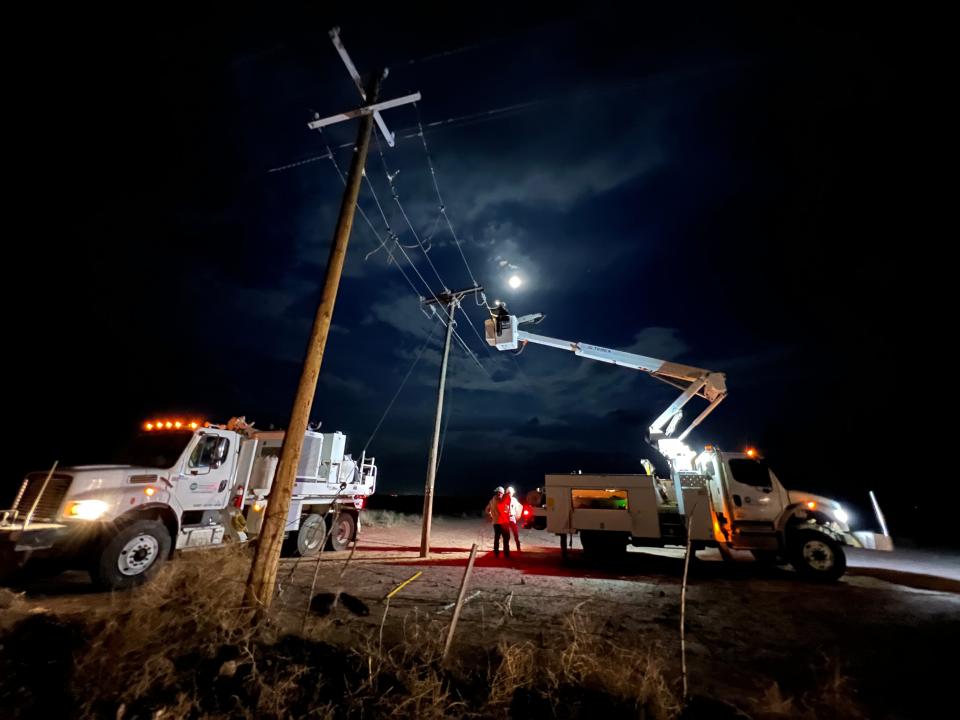Rural electric cooperative in Arizona gives profits to members to offset increased prices
As natural gas prices skyrocket and customers are seeing higher energy bills, one rural energy cooperative decided to offer its entire 2022 profits to help stabilize its members’ bills in an unprecedented decision Wednesday.
Sulphur Springs Valley Electric Cooperative, a nonprofit, is a member-owned distribution cooperative that provides electricity to more than 60,000 locations, including homes, businesses, electric wells and other members.
To help stabilize members’ bills, the organization's board of directors approved a decision to apply the $8 million in profit made last year to the outstanding wholesale power and fuel cost adjuster, a fee that utility companies pass on to consumers to pay for changes in the cost of fuel.
Jason Bowling, the organization's CEO said cooperative members are seeing an additional 5 cents per kilowatt on their bills, which comes out to an average of about $35 per month, in addition to taxes for a standard residential use of 700 kilowatts per month.
“Our rate is approved by the Arizona Corporation Commission and at about 10-cents per kilowatt hour it is among the lowest in Arizona. What we can’t control is the cost of the fuel to generate that electricity, which is what the wholesale fuel cost adjuster charge represents,” Bowling said.
Other companies are also charging a fuel surcharge to pay for increased costs. One company, the Arizona Public Service Co., the largest power utility companies in the state, has $456 million in fuel expenses above the money it collects from customers for fuel.
Sulphur Springs’ unpaid fuel expenses amount to $22 million. Of that total, $10 million was accrued in 2022 and $12 million will be added this year.
"If, as expected, natural gas prices drop in the future, we anticipate that we will be able to lower the fuel adjuster – gradually – and still 'make up' the uncollected energy costs incurred in 2022," Sulphur Springs spokesperson Eric Petermann said in an email.

Adding last year's operating margin to pay part of the debt will allow the company to keep the fuel adjuster at 5 cents per kilowatt-hour without raising it in the immediate future, Petermann wrote.
He noted that without the $8 million going towards the debt, the fuel surcharge would have to be increased even more to pay off the $22 million.
This is not the first time the cooperative has helped members by lowering their bills. The cooperative periodically credits customers with what is called capital credits, or money credited to members from profits made in previous years.
In 2021, the cooperative released the most credits to members it had ever released previously, which amounted to $4 million.
Higher rates: APS customers' bills will soon increase by $12 a month. Here's when and why
In December, the cooperative released $5 million, the most the organization has ever retired in one year to help offset the impact of increased fuel costs due to inflation. Members who received service from 1996, 1997 and 2021 received capital credit payments.
In addition, over the summer, the cooperative decided to take on most of the $10 million it accrued due to rising fuel costs to protect members from a sudden increase in fees.
Bowling said summer is when people use the most electricity and said it could have been “devastating” for customers to see skyrocketing electricity bills. Instead, the cooperative slowly ramped up the increasing costs over several months.

Bowling said the $8 million in profit that will go to paying down the fuel debt would have eventually become capital credits, but that can take a couple decades to accomplish.
Bowling asked members for patience as the cooperative works with outside consultants to decide what the rates will be and how it will impact members’ bills.
He noted that an update is expected in the next few weeks.
Bowling said the organization will continue to do what it can in future years to stabilize energy costs for customers.
Energy source: Arizona still gets a significant amount of power from burning coal. How soon could that change?
The cooperative is also taking steps to invest in renewable energy, including the construction of a 20-megawatt solar array with a 20-megawatt battery system currently under construction in McNeal.
Sulphur Springs is also looking to add two turbines at the Apache Power Station in Cochise County and additional projects in solar and battery systems in the future.
"These steps will enhance reliability and reduce our dependence on a volatile energy market,” Bowling said in a press release.
The organization is also working to lock-in stable prices for the future in what is called financial hedging.
The Arizona Republic reported increased fuel prices are due to multiple factors: use of natural gas in place of coal, hotter summers, a lack of storage and increased exports to Europe.
“We’re at the end of the line when it comes to how much AEPCO pays for the fuel to generate our electricity,” Bowling said, referring to the nonprofit electric generation and transmission company Arizona Electric Power Cooperative. “The difference for us as a Cooperative is that we can apply our operating margins against that uncollected fuel bank charge, where other utilities pass those margins through to their investors.”
The cooperative’s service territory covers parts of Cochise, Graham, Pima and Santa Cruz counties and includes the communities of Sierra Vista, Huachuca City, Patagonia, Elfrida, Benson, St. David, Bowie, San Simon, Willcox, Sonoita and Pearce-Sunsites, according to its website.
Coverage of southern Arizona on azcentral.com and in The Arizona Republic is funded by the nonprofit Report for America in association with The Republic.
Reach the reporter at sarah.lapidus@gannett.com.
This article originally appeared on Arizona Republic: Arizona electric cooperative gives profits to members to offset prices

